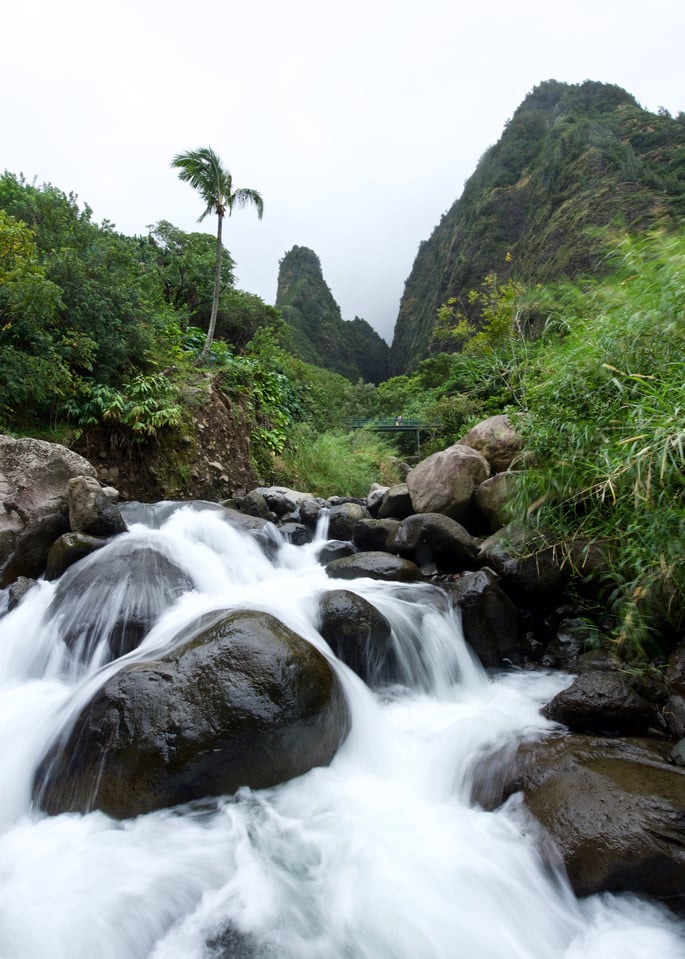I had the pleasure of visiting Maui for a short vacation this past holiday season. Maui is the second largest island by land area in the Hawaiian archipelago. The island is known for its beautiful beaches and tropical landscapes. Prior to my trip I did some research on the types of images I could expect to capture on this island paradise; I saw a lot of wide-angle landscapes around dusk and dawn. As such, I decided to bring my Nikon 14-24mm f/2.8G and Nikon 24-70mm f/2.8G lenses and a travel tripod. It is important to pack lightly when you are traveling. Please enjoy this small sample of landscape images from different locations on Maui.

Table of Contents
Hookipa Beach
When I arrived at this popular surfing spot the sun was starting to go down. Instead of capturing the sunset I shifted my attention eastward to this outcropping of rocks. Every few minutes a big wave would wash over the rocks. I knew that this was the perfect opportunity to add something dynamic to my image. As the sky got darker I adjusted my settings and waited for a big wave.

Waianapanapa Beach
The Road to Hana is one of Maui’s most popular tourist destinations. Near the end of this winding seaside highway is a black sand beach. The sand is black because all of the rocks are volcanic. The black landscape creates an interesting contrast between the clear blue water and lush green plants.

The main beach was full of tourists. I knew it would be difficult to create a clean image with so many people walking around. Instead, I headed to a smaller, rockier beach in the park. Stopping down to f/16 allowed me to capture sharp details in both the foreground and the background. Additionally, this small aperture allowed me to extend my exposure time to create some motion blur in the incoming waves.

Haleakala Summit
Forming 75% of Maui’s land mass and rising over 10,000 feet from sea level is Haleakala. I arrived close to sunset and was met by brutal wind and cold. Despite the harsh conditions, the summit was beautiful. A photographer could spend weeks exploring this otherworldly place. Unfortunately, I had only minutes to capture an image before darkness came. I decided to highlight a shrub in the foreground and the valley in the background. Of all the locations I experienced, this is the one I most want to revisit.

Iao Valley
Covered in lush plants and streams, Iao Valley is famous for its “needle” that rises over 1,200 feet from the valley floor. This landmark is the result of erosion. Despite having some close-up images of the needle, I thought it more interesting to capture the rushing stream in the foreground. The needle can be seen centered in the background.

Makena Beach
The sun was high and strong when I arrived at one of Maui’s most beloved beaches. Shooting into the sun was simply not an option, so I walked to the far side of the beach where I found an outcropping of rocks to stand on. The rocks helped to frame the beach’s crescent shape and gave some details in the foreground. To help deal with the harsh lighting I used a polarizing filter.

Whale Lookout on Route 30
Hawaii is located in the middle of the Pacific Ocean with a relatively small population. This means very little light pollution. At night you can see stars everywhere. Given the chance, I wanted to capture the night sky. Unfortunately, it is impossible to see the Milky Way’s galactic core during the winter months in the northern hemisphere. I was able to capture the edge of our galaxy rising above this ridge on my last night.

Closing Words
Travel photography is a great way to capture memories of your trip abroad. Before embarking on your voyage it is helpful to plan out the types of images you want to capture and pack your camera gear accordingly. The traveling photographer must also remember to balance photography with other aspects of the trip, like eating good food and relaxing on the beach. With a basic plan and the right expectations you can walk away from your next trip with a camera full of memories.
Nice photographs. Which travel tripod you are using?
Maui is the beautiful place to travel and taking photographs. Travel Photography is the best way to capture your memories. Before travelling plan out what type of images you want to capture and pack your camera accordingly. With some planning you can make your memories beautiful by taking good pictures.